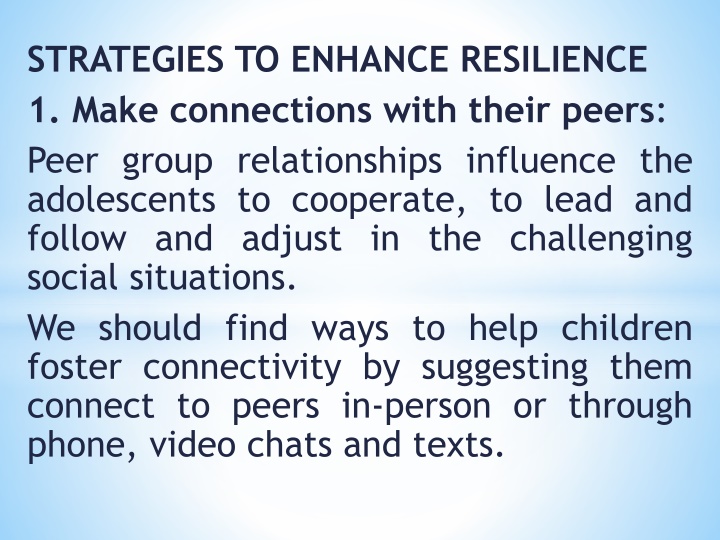
Enhancing Resilience in Adolescents: Practical Strategies
Foster resilience in adolescents by encouraging peer connections, promoting helping others, maintaining routines, allowing breaks, teaching self-care, and nurturing a positive self-view. These strategies provide stability, empowerment, and support during challenging times, aiding in overall well-being and growth.
Download Presentation

Please find below an Image/Link to download the presentation.
The content on the website is provided AS IS for your information and personal use only. It may not be sold, licensed, or shared on other websites without obtaining consent from the author. If you encounter any issues during the download, it is possible that the publisher has removed the file from their server.
You are allowed to download the files provided on this website for personal or commercial use, subject to the condition that they are used lawfully. All files are the property of their respective owners.
The content on the website is provided AS IS for your information and personal use only. It may not be sold, licensed, or shared on other websites without obtaining consent from the author.
E N D
Presentation Transcript
STRATEGIES TO ENHANCE RESILIENCE 1. Make connections with their peers: Peer group relationships influence the adolescents to cooperate, to lead and follow and adjust in the challenging social situations. We should find ways to help children foster connectivity by suggesting them connect to peers in-person or through phone, video chats and texts.
2. Help our child by having them help others: Helping others will realize of moral responsibility to help them care for those Children who may feel helpless can feel empowered by helping others. make our child around him.
3. Maintain a daily routine: Establishing and maintaining a routine is one of the best ways to foster a sense of stability and combat helplessness. Work with our child routine, and highlight times that are for school work and play. Particularly during times of distress or transition, might need to be flexible with some routines. feelings of to develop a
4. Take a break: Although accountable for performance or required to provide certain instructions, build in unstructured time during the school day to allow children to be creative. schools are being held
5. Teach our child self-care: Self-care refers activities we do in order to meet our physical, emotional and mental health needs. It is essential for child s physical, psychological, emotional, spiritual development. There are may options when it comes to self-care activities for adolescents. to the deliberate social,
Self-care activities: Listen to music. Talk to a friend. Watch a movie. Read a book. Go for walk. Play with pet. Do yoga. Write in a journal. Cook with parents, etc.
6. Nurture a positive self-view: Help the child learn to trust themselves to solve problems and make appropriate decisions. At school, help children see how their individual accomplishments contribute to the well-being of the class as a whole.
7. Maintain a hopeful outlook: Even when a child is facing very painful events, help them look at the situation in a broader context and keep a long term perspective. An optimistic and positive outlook can enable children to see the good things in life and keep going even in the hardest times.
8. discovery: Engaging in life allows us to discover more about who I am. Tough times are often more or less faced by all, so when children learn the most about themselves, we help our child take a look at whatever they are facing can teach them What am I made of . Self-discovery helps abilities and helps one to build resilience. Look for opportunities for self- us to identify our
9. Accept change: Change often can be scary for children and teens. Help child to see in a realistic way that change is part of life and new goals can replace become unattainable. In school, point out how students have changed as they moved up in grade levels and discuss how that change has had an impact on the students. goals that have
THANK THANK YOU YOU
